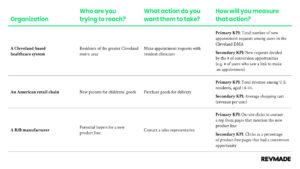Your web analytics should reflect your business outcomes
Home in on the audiences and actions that matter for your organizationMy colleague Andrew wrote recently about one of the pitfalls in performance insights: the temptation to grab easy-to-track metrics as KPIs. They’re right on the front page of your default Google Analytics overview tab, so they must be important, right? Not necessarily! Almost every one of these metrics has at least one fatal flaw when used without context.
- Pageviews: A table stakes view of page engagement, but meaningless with a high bounce rate, little time spent, or among the wrong audience
- Users: It approximates the number of people reached, but does not, by default, unify single-user behavior across multiple devices
- Average Session Duration: It gets at how people are behaving on-site, but is blind toward whether it is quality engagement
In my experience, organizations default to these metrics as primary KPIs when they haven’t deeply addressed the core question which should be at the forefront of a digital strategy: “What is it that we’re trying to do here, anyway?”
It’s a glib way of putting it, but that’s what our analytics setup should hope to answer! What are you trying to accomplish? Are you trying to drive new customer adoption? Promote thought leadership? Simply grow revenue? We distill it down to three core things a client should be able to answer:
Who are you trying to reach?
Simple, right? But if you’re not segmenting KPIs for the right audiences, you might be missing significant trends in your digital strategy.
[ICYMI, Why you need to rethink your audience personas]
Imagine a Houston-based association that is trying to execute a content strategy to drive people to subscribe to its membership. If it’s trying to reach Houston-based businesses, then Houston-area web traffic matters quite a bit more than traffic from Russia. Every KPI should be filtered to look at what this audience is doing and how they are converting.
What action do you want them to take?
This is where most default metrics fall down — they’re too far removed from specific actions to be useful as anything other than secondary measures of content performance.
Using the Houston example again, if the goal is to get subscriptions, then… track new subscriptions as your KPI. Other metrics would only get at more vague categories of audience behavior that wouldn’t explicitly get at that core goal.
How will you measure that action?
Combining metrics with ratios can create a nice view of performance that combines overall impact and nuanced efficacy. You could focus on measuring the number of total conversions over the lifetime of a campaign: first, setting up events to capture conversion clicks from articles to the subscription page, as well as events to track form conversion on that subscription page.
Then, you could get a more accurate denominator for conversion ratios (conversions per opportunity, replacing pageviews) by setting up events to track in-view impressions for conversion links, or even just scroll events to estimate the number of users who had an opportunity to convert. This ratio also becomes a useful KPI to use for any A/B tests you spin up down the line.
I’ve put together a shortlist of sample prompts (and associated metrics) that might be comparable for your organization. Think through what this would look like for your own efforts, and get in touch with us with your questions!

Subscribe
Get our weekly newsletter for tips on how to drive better content marketing performance.
For a regular stream of ideas, research and links we find helpful. And of course, to say hi!
